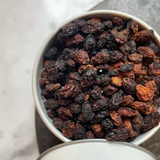Chiloe pepper
Description
Chiloe pepper
Drimys Winteri
Origin: Chile
Net volumes and weights: 50ml / 25g / 0.88 oz
It is also found under the name of sacred pepper, wild Patagonian pepper, sea pepper, Mapuche pepper, Indian pepper, wild Patagonian pepper, etc.
The Chiloé berry is a false pepper, fruit of the Drimys Winteri tree, one of the oldest trees on the planet, a close cousin of the Tasmanian berry.
The term chiloé comes from the island of Chiloé in Chile, where it is found everywhere. The inhabitants of the island call it "Pimienta chilota", translation "Chiloé pepper", because it looks a bit like a red pepper seed: round, wrinkled and brown.
The sacred tree on which Chiloé grows is called Drimys de Winter, bark of Winter, Foye, Canelo or also Magellanic cinnamon. Wild Patagonian pepper grows in clusters on the tree. It looks like an orange-colored raisin.
It is an excellent source of vitamins, especially vitamin C. Among its many virtues are its antioxidant, anti-inflammatory, analgesic, antiscorbutic, healing, anti-rheumatism and antibacterial properties. For the Mapuches, the sacred pepper would cure all diseases. Fruits are excellent for digestion and stomach aches: indigestion, colic, etc. They stimulate the appetite and calm nausea and vomiting.
On the nose, its scent is delicate and fragrant, slightly tart, reminiscent of cranberry and hibiscus. It is not very spicy on the palate, then goes through several vegetable, fruity and empyreumatic flavors, slightly camphorated, with a sweet flavor of lemony candied fruit. The spiciness gradually rises and becomes very present in the middle of the mouth, to gradually lose its strength on the finish.
Usage tips
Use it just crushed in a mortar, rather at the end of the dish, ideally infused in a sauce, a marinade or a stew, but it can be used on a grilled dish without problem. Moreover, it benefits from being lightly roasted before use: dry, 2 minutes in a pan over high heat while stirring so as not to roast it. It does not pass very well in the mill unless it is well roasted.
This rare berry goes perfectly with white meats, veal, pork, lamb and poultry. It also goes well with fish, cooked or in ceviches. It is suitable for many vegetable stews, stews, casseroles and tomato dishes. It will season your green salads with herbs such as mint or marjoram. It will enhance your fresh cheeses and cottage cheeses but also compotes, chutneys and jams. Ideal with red fruits and exotic fruits.




